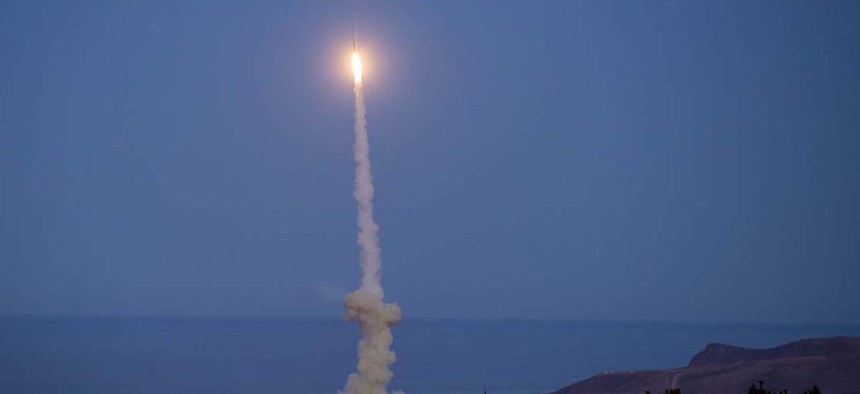
An upgraded ground-based interceptor missile launches at Vandenberg Space Force Base, Calif., Dec. 11, 2023. U.S. Space Force / Ryan Keith
What 2024 has in store for Space Force acquisition
Several troubled programs appear finally set to deliver.
Fourteen months ago, Space Force acquisition chief Frank Calvelli released acquisition guidelines, or “tenets,” meant to help the service buy smaller, cheaper satellites and move away from behemoth, delay-prone programs. Now Calvelli wants to reinforce these reforms.
“I'm really happy with them and I wouldn’t change a thing. In fact, I would double down on them right now,” he said in November during Aviation Week’s Aerospace & Defense Programs conference.
Next year, Calvelli expects the Space Force to finally deliver on a few “problem children” programs, including a space command-and-control system, called ATLAS for Advanced Tracking and Launch Analysis System; and new ground stations to control the Pentagon’s constellation of GPS satellites, called GPS Next Generation Operational Control Segment, or OCX.
These programs have faced delays because “big software developments fail,” Calvelli said in November. “We've seen failures in big software and OCX just fits right into that mold. It's a very large complex software system that's had its challenges.”
ATLAS is set to replace the Pentagon's 45-year-old Space Defense Operations Center, or SPADOC. It was slated to be finished in 2022, but its “baseline capability” is now expected to arrive in August. It will enter service only after an “operational trial period, the length of which has not yet been finalized,” an Air Force department official said.
The OCX program, which will replace current ground stations, is more than seven years behind schedule. Delivery is planned for June, but developmental testing, crew training, and other activities will keep it out of operations until February 2025, the department official said.
The system will be operational when it can “operationally support command and control of all GPS III and legacy GPS space vehicles, can monitor and broadcast GPS navigation signals, and can support mission planning,” the official said.
Calvelli said he will continue to press the OCX and ATLAS programs.
Next year will also see the service test two variants of a card designed to help GPS receivers resist jamming. These Military GPS User Equipment Increment 1 ground cards, or MGUE, have completed development and are being integrated and fielded into ground platforms, according to the official.
The final two acquisition milestones for the program—developing the aviation and maritime cards—are on track for operational testing next year on the Air Force’s B-2 bomber in July and the Navy’s DDG-class destroyer in October, the official said.
More launches
The Space Force will nearly double its national-security space launches next year, from 12 launches in fiscal 2023 to 21 in 2024.
Of those 21 missions, ULA will launch 11 and SpaceX 10. The Pentagon is working to usher new companies into the heavy-lift market dominated by the two companies. Last February, officials announced that its next satellite-launch competition will split the bidding for dozens of launches into two groups: Lane 1 for “more risk-tolerant” missions, and Lane 2 for more challenging and “critical” ones. They said they will select three companies for Lane 2, which launches in 2025.
Still, officials have maintained they aren’t concerned about the Pentagon’s dependence on Elon Musk’s SpaceX to launch crucial satellites into space. SpaceX has done an “amazing job” at “revolutionizing” access to space, Calvelli said in November.
However, he said, ULA’s Vulcan Centaur rocket, which will compete against SpaceX’s Falcon 9, needs to launch soon. The much-delayed heavy-lift rocket is now set to blast off in early 2024.
“We need Vulcan. It’s a couple years late to show up to the party. And we would love to see other competitors out there like Blue Origin be successful with their rocket, and as well as folks at Rocket Lab have plans for future rockets as well. So there's plenty of stuff to launch and the more the merrier,” Calvelli said.
As the Space Force tries to diversify the launch market, industry has been working on getting payloads into space as quickly as possible. The service set a record for its speediest launch in 2023, launching a satellite 27 hours after receiving orders.
This was part of the “Victus Nox” program, which will give the Pentagon the ability to quickly respond to threats in space or augment a degraded or destroyed U.S. space system. Having this capability is key for the Space Force’s effort to maintain a resilient constellation of hundreds of military satellites in space, and send more up there quickly if one of them gets damaged.
The Space Development Agency, one of the Space Force’s acquisition arms, started building out this constellation in 2023, launching batches of satellites into low-Earth orbit. This constellation, called the “Proliferated Warfighter Space Architecture,” will start delivering operational capabilities for warfighters in 2024.




